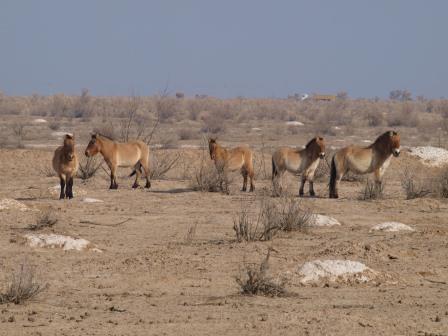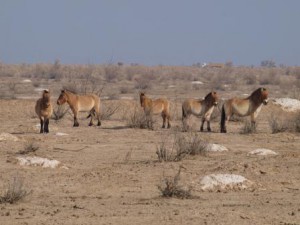15th January 2015 Tashkent, Uzbekistan
New Year

Last weekend I joined a group of Tashkent bird-watchers for the annual new-year count of water birds at the Tuyabuguz reservoir. It’s part of a world-wide effort co-ordinated by Wetlands International, in which Uzbekistan has participated for the last eight years. The weather was terrible – cold and rainy and misty – but we did what we could, and our results will feed in to a global survey of the state of the world’s bird life. Small actions like these, across the globe, add up to an important information base that should help all those organisations and governments that are working to support biodiversity and conservation. And even in the rain it’s sometimes good to get out of the city and closer to nature.
 Just before Christmas we spent two days at a nature reserve near Bukhara whose main purpose is to sustain populations of goitered gazelle (or jeyran), wild asses and Przewalski’s horses, part of the historic fauna of the Kyzyl Kum desert, but all under severe pressure in the wild. The Ecocentre was established in May 1977 under Uzbekistan’s State Committee for Nature Protection. It’s run by a dedicated – and very welcoming – team of experts who know every corner of its 16000 hectares and are happy to explain the different habitats of the reserve and the plant and animal life they shelter.
Just before Christmas we spent two days at a nature reserve near Bukhara whose main purpose is to sustain populations of goitered gazelle (or jeyran), wild asses and Przewalski’s horses, part of the historic fauna of the Kyzyl Kum desert, but all under severe pressure in the wild. The Ecocentre was established in May 1977 under Uzbekistan’s State Committee for Nature Protection. It’s run by a dedicated – and very welcoming – team of experts who know every corner of its 16000 hectares and are happy to explain the different habitats of the reserve and the plant and animal life they shelter.
At the Ecocentre they are also breeding mouflon or urial, mountain sheep with huge curved horns that are recognisably the same animals portrayed in the petroglyphs of Sarmysh, north of Navoi. Very little is known (or at least very little that I’ve been able to find out) about the meaning and purpose of rock art of this kind – although it’s interesting to note that it’s all animals or people – there are no trees or houses or mountains or even birds. And the quality is very variable. But some of these carvings (and they remind me a bit of much older cave paintings in Europe) capture the essence of an animal in a few elegant lines. I’d like to know more. It’s not clear to me who the people were who made these picture; how, if at all, they are related to the people who live in the Sarmysh and Navoi region today: there are places in the UK, for example, where it’s possible to trace the descent of the present-day population from the known Neolithic inhabitants.
This year, 2015 has been declared the International Year of the snow leopard, under the Bishkek Declaration of 2013, of which Uzbekistan is a signatory. The idea is to communicate to the wider public and a range of stakeholders the importance of protecting these magnificent animals and the ecosystems they depend on.
And more importantly, 2015 is the year in which the international community is due to meet in Paris to agree on the shape of a global agreement, to come into force in 2020, on combating climate change. The world has been talking about this for a long time, but greenhouse gas emissions have continued to rise. It’s time for real action and it needs to involve all of us.